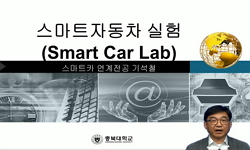The heat generated by the bulbs in automotive lamps is transferred to the reflector and lens of the lamp through the heat transfer mechanism. If the heat transferred to the reflector and lens exceeds the heat resistance limit of the materials used in ...
http://chineseinput.net/에서 pinyin(병음)방식으로 중국어를 변환할 수 있습니다.
변환된 중국어를 복사하여 사용하시면 됩니다.
- 中文 을 입력하시려면 zhongwen을 입력하시고 space를누르시면됩니다.
- 北京 을 입력하시려면 beijing을 입력하시고 space를 누르시면 됩니다.


차량용 램프 내열 온도 예측을 위한 CFD 해석 및 알고리즘 개발 = CFD Analysis and Algorithm Development for Predicting Heat-resistant Temperature of Automotive Lamps
한글로보기https://www.riss.kr/link?id=A108649931
- 저자
- 발행기관
- 학술지명
- 권호사항
-
발행연도
2023
-
작성언어
Korean
-
주제어
자동차 ; 램프 ; 온도예측 ; 열전달 ; 전산유체역학 ; Automobile ; Lamp ; Temperature estimation ; Heat transfer ; CFD
-
등재정보
KCI등재,SCOPUS
-
자료형태
학술저널
- 발행기관 URL
-
수록면
557-565(9쪽)
- 제공처
-
0
상세조회 -
0
다운로드
부가정보
다국어 초록 (Multilingual Abstract)
We designed box-shaped lamps considering the size range of the actual manufactured lamps and using the heat transfer mechanism. The relationship between the maximum temperature of each surface obtained through CFD and the main factors including the size of the box, power of the bulb, and ambient temperature were verified. Based on these results, we developed a single-function lamp temperature prediction algorithm.
The heat generated by the bulbs in automotive lamps is transferred to the reflector and lens of the lamp through the heat transfer mechanism. If the heat transferred to the reflector and lens exceeds the heat resistance limit of the materials used in their production, deformation occurs. Therefore, designers must design lamps within a limited range, and if the lamps fail to pass the heat resistance test after design and production, the design process must be restarted from the beginning, which incurs considerable time and cost. By using a heat resistance prediction program, designers can save a significant amount in terms of time and cost that were previously required during the design-heat resistance test phase. Therefore, in this study, we sought to understand the temperature characteristics of lamps based on the heat transfer mechanism, using computational fluid dynamics(CFD) results for the development of a high-accuracy temperature prediction program for automotive lamps.
We designed box-shaped lamps considering the size range of the actual manufactured lamps and using the heat transfer mechanism. The relationship between the maximum temperature of each surface obtained through CFD and the main factors including the size of the box, power of the bulb, and ambient temperature were verified. Based on these results, we developed a single-function lamp temperature prediction algorithm.
참고문헌 (Reference)
1 K. F. Sokmen, "Thermal Computations of Temperature Distribution and Bulb Heat Transfer in an Automobile Headlamp" 50 (50): 199-210, 2013
2 J. Wulf, "Temperature Loads in Headlamps" 2002
3 E. W. Liang, "Predicting the Thermal Performance of an Automotive Fog Lamp Reflector" 106 : 1458-1473, 1997
4 T. Poorman, "Methodology to Evaluate Automotive Lamp Venting" 112 : 753-757, 2003
5 MatWeb, "LLC"
6 B. Choi, "Improving Process and Reliability of Thermal Analysis on Lamp" 1603-1608, 2012
7 F. P. Incropera, "Fundamentals of Heat and Mass Transfer" John Wiley & Sons 2018
8 J. Lee, "Development of Temperature Prediction Simulation Program for Automotive Headlamp" 988-994, 2020
9 T. K. Philip, "Design of an Automotive Headlamp Considering Style and Performance" 46 (46): 2013
10 T. Poorman, "Automotive Lighting Thermal Performance Prediction Methods" 2001
1 K. F. Sokmen, "Thermal Computations of Temperature Distribution and Bulb Heat Transfer in an Automobile Headlamp" 50 (50): 199-210, 2013
2 J. Wulf, "Temperature Loads in Headlamps" 2002
3 E. W. Liang, "Predicting the Thermal Performance of an Automotive Fog Lamp Reflector" 106 : 1458-1473, 1997
4 T. Poorman, "Methodology to Evaluate Automotive Lamp Venting" 112 : 753-757, 2003
5 MatWeb, "LLC"
6 B. Choi, "Improving Process and Reliability of Thermal Analysis on Lamp" 1603-1608, 2012
7 F. P. Incropera, "Fundamentals of Heat and Mass Transfer" John Wiley & Sons 2018
8 J. Lee, "Development of Temperature Prediction Simulation Program for Automotive Headlamp" 988-994, 2020
9 T. K. Philip, "Design of an Automotive Headlamp Considering Style and Performance" 46 (46): 2013
10 T. Poorman, "Automotive Lighting Thermal Performance Prediction Methods" 2001
11 Y. Chang, "A Study of Thermal Factor of Automotive Lamps using CFD" 77-883, 2010
12 X. Long, "A Review on Light-emitting Diode Based Automotive Headlamps" 41 : 29-41, 2015
동일학술지(권/호) 다른 논문
-
차량용 라이다 센서를 위한 실시간 표면 오염 판단 알고리즘
- 한국자동차공학회
- 원종진
- 2023
- KCI등재,SCOPUS
-
정밀도로지도 기반 자율주행 테스트베드용 VILS 시스템 구현
- 한국자동차공학회
- 이원종
- 2023
- KCI등재,SCOPUS
-
강도, 회전 내구성 및 비틀림 내구성을 고려한 인텀 샤프트 어셈블리의 설계
- 한국자동차공학회
- 방우석
- 2023
- KCI등재,SCOPUS
-
- 한국자동차공학회
- 남충우
- 2023
- KCI등재,SCOPUS




 DBpia
DBpia






